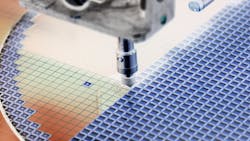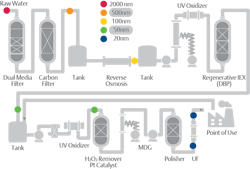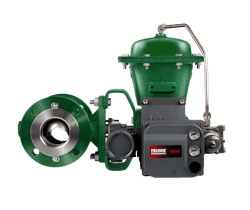Control valve selection for semiconductor ultrapure water applications
Since its discovery in 1959, the silicon chip has faced an unceasing drive to improve computing speed through component minimization. As transistors shrink to nanoscale sizes, the purity of the water required to produce these chips must achieve near perfect conditions. Achieving and maintaining these levels of purity requires control valves with very specific features.
This article discusses the requirements for producing ultrapure water and it details the features control valves must incorporate to succeed in that application.
Silicon chip manufacturing
The fabrication of silicon chips starts with a wafer of very pure silicon which is gradually built up with layer upon layer of various materials to create the required transistors, logic components and electrical connections necessary for the chip design. This process requires numerous steps of building layers, selectively etching channels and refilling those channels with new materials to eventually create three-dimensional silicon chips across the face of the wafer (Figure 1).
After the processing of each layer, the wafer is rinsed and then subjected to chemical mechanical planarization, which essentially polishes the surface flat using a mix of special chemicals, light abrasives and copious amounts of ultrapure water. A 30 cm wafer requires about 2,200 gallons (8,328 liters) of water for fabrication, which includes 1,500 gallons (5,678 liters) of ultrapure water.
Not just any water
The ultrapure water used in semiconductor operations is a far cry from the typical plant water used in most industrial facilities. Even carefully treated deionized or demineralized water, which many would consider very high quality, would not begin to approach the purity specifications demanded by semiconductor manufacturing. A few of the extensive water purity specifications are listed here:
As stringent as these specifications are now, they are growing tighter with each successive generation of chip miniaturization. Historically, transistor chip size has followed Moore’s law, with the speed and capacity of the chips doubling about every two years, requiring component size to be half as large.
With every generation of progressively smaller transistor and chip components, the purity requirements for ultrapure water grow increasingly restrictive because the chips are becoming sensitive to smaller particles and lower levels of contamination.
The process to create this ultrapure water is already quite involved and is growing more complicated as the purity specifications are tightened (Figure 2). The influent for ultrapure water production is usually municipal drinking water, which is then subjected to a variety of steps to gradually remove impurities.
There are losses as these steps are performed, so it takes approximately 1.5 gallons (5.7 liters) of incoming water to create a gallon of ultrapure water. Given the vast quantities of water involved and the huge energy cost of processing, water purification and use are one of the major cost drivers of a semiconductor fabrication facility.
Keeping ultrapure water ultrapure
Making ultrapure water is expensive and difficult. Keeping ultrapure water ultrapure is quite challenging as well. The lack of mineral and ionic content makes the water quite aggressive, actively trying to draw ions from its surroundings. Particulates can be introduced into the water from corrosive attack of the piping system, or by piping component degradation over time. Some bacteria can survive the ultrapure water purification process and others may be introduced into the supply lines during maintenance activities. If introduced into the ultrapure water system, the bacteria can create biofilms that are very resistant to cleaning and sanitizing measures, and thus prove difficult to eliminate.
For these reasons the tanks, piping and control valves that make up the ultrapure water system must be very carefully chosen, or the ultrapure water will fall out of specification in a very short time.
Control valves for ultrapure service
Control valves in ultrapure water service must meet a variety of restrictive specifications. Obviously, the valve itself must meet the process conditions typical of any control valve application, which might include operation at specific pressures and temperatures and flow rates, along with anti-cavitation and other requirements. However, these valves have additional requirements specific to ultrapure water including:
- Special material selection of body, trim and seal material components.
- Elimination of any lubricants in the assembly process.
- Careful cleaning and packing to keep the valve free of any dust or particulate.
- Component treatment to achieve very specific levels of surface roughness.
The material selection generally eliminates any graphite components as these can introduce particles into the water. It also ensures any wetted materials will resist attack from the water. The valve assembly and packing process must be lubricant free, and this requires a clean room environment and complex handling procedures to avoid introducing external dust or particles which might make their way into the water system. However, the surface roughness requirements are the most difficult to achieve.
Surface roughness is critical to maintaining ultrapure water specifications because a smooth surface is easy to clean and offers no place for bacteria to establish a foothold. Surface roughness (Ra) is normally measured in microinches or microns, and it is the absolute average of the surface heigh.
Control valves in ultrapure water service usually require a Ra of 35 microinches or less. To achieve these demanding specifications, any wetted valve components must be carefully processed and electropolished to establish a chromium oxide finish that is very smooth, resulting in a surface that is 30 times more resistant to chemical attack than prior to polishing.
Finding control valves that meet all these specifications is not easy, but there are a few manufacturers that sell ultrapure water versions of their standard control valves (Figure 3). These valves often incorporate standard high performance control valve features, including diagnostic digital positioners and full-featured actuators, and they are available for a wide range of flow sizes.
In addition, the valves undergo special procedures to prepare them for use, one of which is the chemical passivation of finished stainless steel components machined from castings. Chemical passivation is a chemical treatment with a mild oxidant, such as nitric acid, and it is typically performed per the requirements of ASTM A380 or ASTM A967. After cleaning, the valve components are inspected to ensure removal of embedded iron, iron-oxide scale and other iron-based compounds from the surface — each of which can cause the formation of rust on the surface of the stainless steel.
After passivation, valves are cleaned with a special agent, using a process similar to that used when preparing valves for oxygen service. This process takes place in a dedicated clean room, where special care is taken to eliminate exposure of the assemblies to contaminants (Figure 4).
Assemblies are then specially packaged to ensure their cleanliness is not compromised during transport.
Seek advice
When choosing a control valve for ultrapure water applications, semiconductor manufacturers should evaluate valve models with a proven track record of successful applications in that specific service. The manufacturing protocols for cleanliness are significant and exacting, and the additional manufacturing process steps are critical to meet the cleanliness and surface roughness specifications demanded by ultrapure applications. Manufacturers should consult with their valve vendor during the selection process because these ultrapure water features are considered a specialty application, and many of the available options may therefore not be called out in the standard control valve literature.
Mark Nymeyer is the hybrid industry manager on the Global Industry Sales team at Emerson for their flow controls products. In his 12 years at Emerson, he also served as the product marketing manager for their Fisher rotary valve and actuator product lines. Nymeyer works at the Emerson Innovation Center in Marshalltown, Iowa. He holds a BS degree in Marketing from the University of Iowa and is a Certified Functional Safety Professional.
Rohit Anand is a senior application engineer at Applied Control, and Emerson Impact Partner. He works in the Fisher Valve Division and has over 15 years of experience applying control valves for various upstream and downstream applications. Anand supports various Emerson products, including control valves, regulators and desuperheaters, with a focus on the pulp and paper, semiconductor, chemical, refining and natural gas industries. He holds a BS degree in Mechanical Engineering from the G.B Pant Engineering University in India.
Emerson





